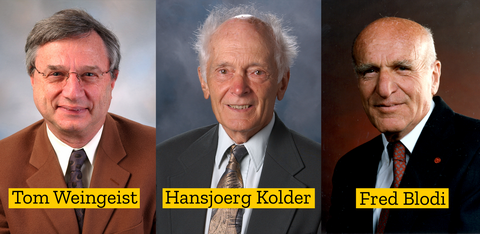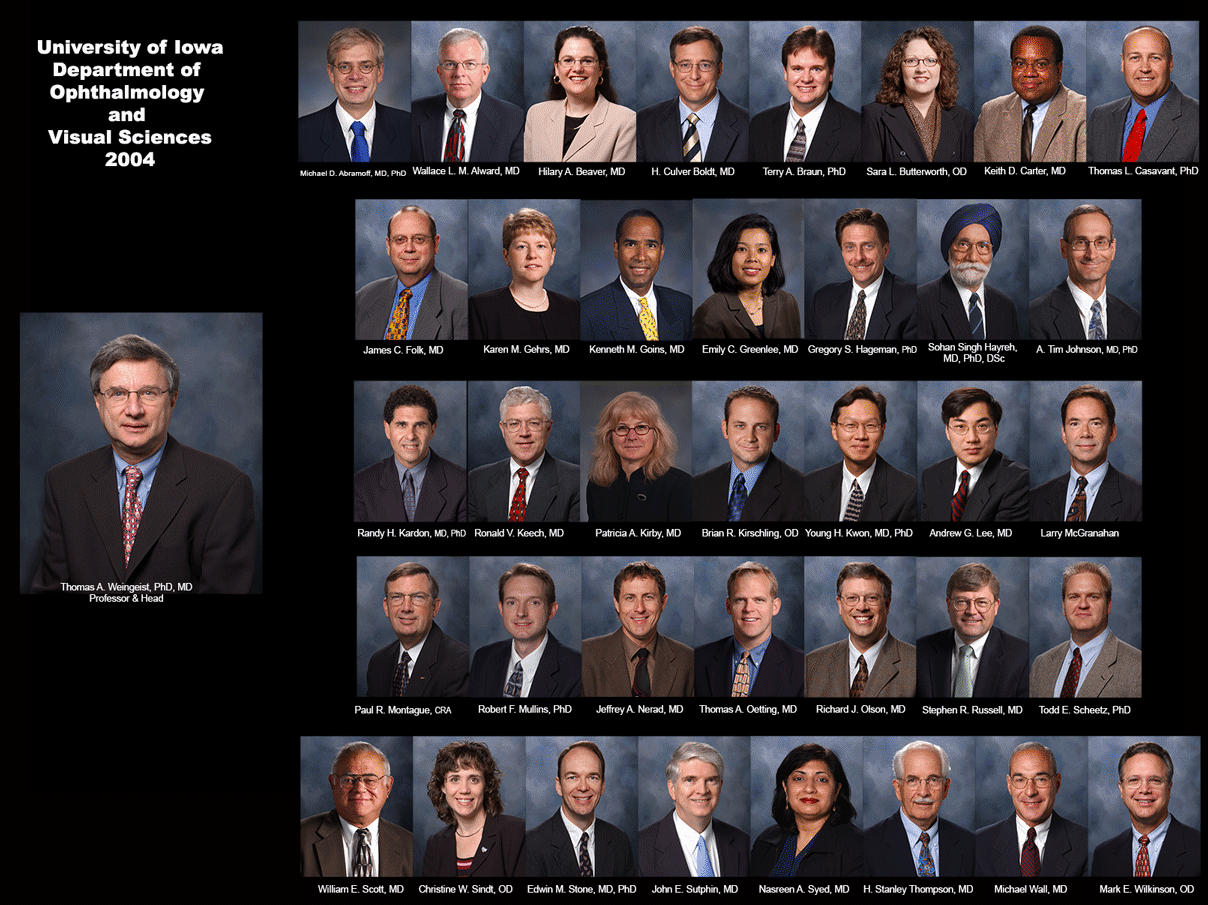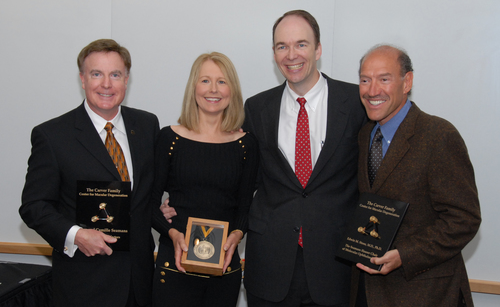Main navigation
The University of Iowa's Department of Ophthalmology has long been a pillar of innovation, education, and patient care. Between 1995 and 2004, the department cemented its status as one of the nation's premier ophthalmology programs through groundbreaking research, state-of-the-art facilities, and a commitment to excellence in clinical care. From leadership transitions to scientific discoveries, this decade was marked by remarkable achievements that shaped the future of eye health.
Leadership and Expansion

In 1995, Dr. Thomas Weingeist ascended to the presidency of the Association of University Professors of Ophthalmology, solidifying the University of Iowa's influence in the national ophthalmology landscape. That same year, the department bid farewell to Dr. Hansjoerg Kolder, who transitioned to professor emeritus status after a distinguished career pioneering electrophysiology of the eye. Additionally, Dr. Frederick C. Blodi was honored with an "Honorary Membership" by the American Ophthalmological Society, the highest accolade bestowed by the organization.
One of the most significant developments came in 1996 with the opening of the Eye Institute in the Pomerantz Family Pavilion. This state-of-the-art facility revolutionized patient care, research, and education, providing a cutting-edge environment for faculty, residents, and fellows. This milestone was followed by the establishment of the Carver Molecular Ophthalmology Laboratory, ensuring continued groundbreaking research in genetic eye diseases.
The Move to the Pomerantz Family Pavilion in 1996

Key Faculty Additions 1995 to 2004

1995 - Drs. A. Timothy Johnson and Christine Sindt
- Dr. A. Timothy Johnson (Comprehensive Ophthalmology & Glaucoma)
Dr. Johnson, a former Iowa resident (1991), returned to the department after serving at the Kellogg Eye Center at the University of Michigan. His expertise in glaucoma and comprehensive ophthalmology helped advance patient care and resident education. - Dr. Christine Sindt (Contact Lens & Low Vision Clinics)
Dr. Sindt joined as a specialist in contact lenses and low vision rehabilitation. She played a critical role in advancing contact lens technology and patient care, including work on specialty lenses for corneal diseases.
1996 - Drs. John Sutphin, Karen Gehrs, Young Kwon and Stephen Russell
- Dr. John Sutphin (Cornea & External Diseases)
Dr. Sutphin became a major force in the department's corneal program, particularly in the use of confocal microscopy for diagnosing Acanthamoeba keratitis. His work significantly improved early detection and treatment of complex corneal infections. - Dr. Karen Gehrs (Retina) joined the department as an assistant professor. She completed her residency in ophthalmology and a vitreoretinal fellowship at Duke University, where she was also chief resident and clinical associ ate. She was an assistant professor of ophthalmology at the Anheuser Busch Eye Institute, St. Louis University and then joined a private practice, Mid-America Retina Consultants, in Kansas City, Missouri.
- Dr. Young Kwon (Glaucoma) is hired as an assistant professor. He comes to Iowa after completing a Glaucoma fellowship and research projects titled, "optic disc analy sis of patients with glaucoma using confocal laser scanning ophthal moscopy, HRT" and a "novel way of presenting visual field data emphasizing defect location as well as defect amplitude."
- Dr. Stephen Russell (Retina) was appointed associate professor after serving as an associate professor St. Louis University since 1988. Dr. Russell completed his viteoretinal diseases and surgery at UI before joining the faculty at the University of St. Louis.
1997 - Drs. Thomas Oetting and Mark Wilkinson
- Dr. Thomas Oetting (Comprehensive Ophthalmology) completed his residency at UI in 1995 and served in a private practice in Jefferson City, Missouri, as well as serving as a clinical instructor at the Truman VA Medical Center in Columbia, Missouri. In his role as assistant professor, he plans on working closely with residents in teaching general ophthalmology and cataract surgery to residents.
- Dr. Mark Wilkinson (Optometry and Vision Rehab) served as a low vision clinician at UI from 1984 to 1986 before going into private practice. He joins the faculty as a associate professor and will serve as the Director of Low Vision Rehab.
1999 -Dr. Michael Wagoner
- Dr. Michael Wagoner (Cornea) joins the department after serving as the director of the King Khaled Eye Hospital in Saudi Arabia. Dr. Wagoner is also the editor-in-chief of The middle East Journal of Ophthalmology. He will work in the cornea clinic and serve as the co-medical director of the Iowa Lions Eye Bank.
2000 - Drs. Andrew Lee and Hilary Beaver
- Dr. Andrew Lee (Neuro-Ophthalmology) brought expertise in neuro-ophthalmology, further strengthening the department’s ability to diagnose and manage neurological disorders affecting vision. His research and clinical work contributed to advancements in understanding optic nerve diseases.
- Dr. Hilary Beaver (Comprehensive Ophthalmology & Cataract Surgery) specialized in comprehensive ophthalmology and cataract surgery, offering valuable surgical training to residents and fellows.
2001 - Dr. Robert Mullins
- Dr. Robert Mullins (Center for Macular Degeneration) originally came to the department in 1997 as a research assistant under Dr. Greg Hageman. He was also a postdoctoral fellow with the University of Iowa Center on Aging. He will serve as assistant professor and plans to develop and study animal and in vitro models of age related macular degeneration.
2002 - Drs. Gregory Hageman, Richard Olson and Nasreen Syed
- Dr. Gregory Hageman (Retinal & Macular Degeneration Research)
A leading researcher in age-related macular degeneration (AMD), Dr. Hageman's work earned him the prestigious Lew R. Wasserman Merit Award. He played a crucial role in securing major research grants and advancing the understanding of AMD pathophysiology. - Dr. Richard Olson (Pediatric Ophthalmology and Adult Strabismus) joins the faculty as an associate professor in July. He is an investigator in the Pediatric Eye Disease Investigator Group and the Amblyopia Treatment Study, and was a resident and pediatric fellow at UI from 1992 to 1997
- Dr. Nasreen Syed (Ocular Pathology) joins the faculty as director of the F.C. Blodi Pathology Lab. She joins Iowa after serving as assistant professor at the University of Pennsylvania School of Medicine. Her research interests include ophthalmic pathology, uveitis, and retinal degenerations
2003 - Dr. Kenneth Goins
- Dr. Kenneth Goins (Cornea) joins the faculty as an associate professor. Prior to joining the faculty, Dr. Goins the University of Chicago Hospitals and Southeastern Eye Clinic. He completed his residency at the University of Kentucky before completing a fellowship in Cornea and External Diseases at Duke University.
2004 - Dr. Michael Abràmoff
- Dr. Michael Abràmoff (Retina), a specialist in ophthalmic imaging research, is hired as an assistant professor after spending the past year working as a visiting fellow on a optical functional imaging of the retina project with Drs. Randy Kardon and Young Kwon.
Scientific Breakthroughs and Research Milestones
The department made significant strides in ophthalmic research, particularly in molecular genetics. In 1997, Dr. Val Sheffield was appointed as an investigator by the prestigious Howard Hughes Medical Institute, recognizing his pioneering work in genetic ophthalmology. That same year, the University of Iowa Center for Macular Degeneration was established, focusing on research and treatment of age-related macular degeneration.
In 1998, Drs. Edwin Stone, Wallace Alward, and Gregory Hageman launched a five-year project to identify new targets for glaucoma drug development. This research culminated in 1999 with the prestigious Lewis Rudin Glaucoma Prize, awarded for their publication identifying a gene responsible for primary open-angle glaucoma. Dr. Sohan Hayreh, a leading expert in ocular vascular diseases, received a $60,000 Senior Investigator Award from Research to Prevent Blindness in the same year, supporting his continued contributions to the field.
The turn of the millennium ushered in further research accolades. In 2000, the "Coming to Your Senses" program was launched in collaboration with the Otolaryngology Department, leading to the Iowa KidSight initiative, which screened young children for early vision and hearing impairments.
In 2002, Dr. Gregory Hageman received the Lew R. Wasserman Merit Award from Research to Prevent Blindness for his contributions to understanding macular degeneration. The department also secured a $3.2 million grant from Alcon Laboratories to support glaucoma research, followed by a $3.5 million grant from CIBA Vision Corporation in 2003 to fund research on age-related macular degeneration. By 2004, Drs. Edwin Stone and Andrew Lotery had secured a $240,000 grant from Ronald McDonald House Charities for research into Stargardt disease and early-onset macular degeneration.
In 1997, Dr. Ed Stone identified two key factors driving the success of the Molecular Ophthalmology Laboratory (MOL): collaboration among experts with different specialties and a strong focus on patient needs. Recognizing the need for a dedicated organization to foster such partnerships, he helped establish the University of Iowa Carver Family Center for Macular Degeneration (CMD). Since traditional NIH grants were too small for large-scale, interdisciplinary research, he also saw the need for philanthropic support. The center was named after its primary focus: age-related macular degeneration (AMD).
Click the sections below to continue reading
Building a Team of Experts
Stone and Dr. Tom Weingeist recruited a distinguished group of AMD researchers to Iowa City, including Greg Hageman, Steve Russell, Karen Gehrs, Markus Kuehn, and Rob Mullins. At the same time, Dr. Val Sheffield brought in gene discovery specialist Bento Soares. Additional experts like Tom Casavant from the Department of Electrical and Computer Engineering and Bev Davidson from Internal Medicine joined the initiative. By September 1997, their collective efforts officially formed the University of Iowa Center for Macular Degeneration.
A scientific meeting marked the launch of the center, with world-renowned ophthalmology experts in attendance. The keynote speaker was Dr. Alan Bird. The early years saw significant contributions from UK research fellows Andrew Webster and Andrew Lotery. Webster’s research clarified that the ABCA4 gene was not a significant factor in AMD, a controversial finding at the time. Lotery used genetic screening to link several diseases, previously thought to be separate conditions, to a single gene. Another key contributor, Dr. Elise Héon, helped trace a rare eye disease to a Swiss valley, further advancing genetic discoveries.
The Role of Philanthropy
Stone realized that traditional university fundraising efforts were unlikely to prioritize a single research group in a small department. To elevate his group to a "top ten" level in research, he needed major philanthropic support. So, he reached out to four individuals to form an advisory board that could help raise funds and promote the group’s mission to cure blindness within the university.
- Jack Johns – A businessman whose daughter had a Stargardt-like condition.
- Paul Rosenthal – A Washington, D.C. attorney recruited by Johns.
- Leo Hauser – A patient with retinitis pigmentosa who enthusiastically joined after asking how he could help.
- Gary Seamans – An electrical engineer and son of an AMD patient.
Initially, the board aimed to raise $40,000, but by the end of their first meeting, that goal had grown to $7 million. Over time, additional members, including Cammy Seamans, Ruth Carver, Marty Carver, and J. Nelson, joined the effort. Their collective work led to a strategic planning initiative in 2005, defining CMD’s mission to become a global leader in retinal disease research.
Expanding Research and Impact
The new board met quarterly and gradually expanded to include Cammy Seamans, whose mother had AMD; Ruth Carver, whose mother and siblings had Best disease; Marty Carver, whose parents were the namesakes of the Carver College of Medicine at the University of Iowa; and J. Nelson, a Chicago telecommunications executive originally from Boone, Iowa.
The word was out about the CMD and people across the country started noticing. In 2002 Ed Stone elected to the Howard Hughes Medical Institute (HHMI)—making him the only practicing ophthalmologist ever elected. Val Sheffield had been elected to HHMI five years earlier, reflecting the center’s strong culture of collaboration and innovation.
In September 2005, the board led a strategic planning effort involving individuals from across the University of Iowa. Their goal was to define the mission and identity of the Center for Macular Degeneration (CMD). They decided the center should strive to be the leading clinical and research organization in retinal degenerative disease.

In 2006, Gary and Cammy Seamans partnered with Leo Hauser to establish the center’s first endowed chair—the Seamans-Hauser Chair of Molecular Ophthalmology for Ed Stone. The following year, Marty Carver and his brothers, Roy Jr. and John, donated $10 million to the University to rename the center as the Carver Family Center for Macular Degeneration. Their gift also funded two additional endowed chairs, for Val Sheffield and Tom Casavant, and helped establish the John and Marcia Carver Nonprofit Genetic Testing Laboratory (CNGTL). Since its creation, the CNGTL has provided affordable genetic testing to thousands of patients across all 50 U.S. states and more than 60 countries.
During this period, new advisory board members joined, including John Pappajohn, an entrepreneur and philanthropist from Des Moines; Bruce Spivey, a former faculty member of the ophthalmology department at Iowa and later at UCSF; Tim Sear, former CEO of Alcon Pharmaceuticals; and John O'Brien, a businessman from Cleveland with a strong interest in vision research and support services for the visually impaired.
Other major honors during the Carver Family Center for Macular Degeneration (CFCMD) years included The Cogan Award, The Doyne Lecture, and the Jackson Memorial Lecture for Stone, as well as recognition by the American Association of Physicians and the National Academy of Medicine for Sheffield.
Project 3000: A Nationwide Effort
In 2000, the research community focused on Leber Congenital Amaurosis (LCA) after a groundbreaking gene therapy trial at the University of Pennsylvania restored sight in dogs. The CFCMD team anticipated future human trials and launched Project 3000 to identify and genetically test every person in the U.S. with LCA (about 3,000 individuals). The initiative gained support from high-profile figures like Wyc Grousbeck (Boston Celtics owner) and Derrek Lee (Chicago Cubs first baseman). The project succeeded in identifying over 90% of affected individuals under age 20—the prime candidates for treatment.
In 2008, the advisory board conducted another strategic planning session with the enthusiastic support of University President Sally Mason. This effort laid the foundation for the Institute for Vision Research, established in 2010.
The Legacy of The Carver Family Center for Macular Degeneration
From 1998 to 2009, CFCMD published 207 research papers, with several receiving well over 200 citations. Their discoveries significantly advanced our understanding of:
- Age-related macular degeneration (AMD)
- Bardet-Biedl syndrome
- Leber congenital amaurosis
- Enhanced S-cone syndrome
They also developed an efficient genetic testing strategy for complex inherited retinal diseases. Thanks to its pioneering research, philanthropic support, and strong collaboration, the center continues to lead the way in vision science, bringing hope to thousands of patients worldwide.
Training the Next Generation of Ophthalmologists
Throughout the decade, the University of Iowa Ophthalmology Department remained committed to educating future leaders in the field. Each year saw the successful graduation of residents and fellows who carried forth the department’s legacy of excellence. The department's dedication to training was evident in the comprehensive and rigorous programs offered, which included hands-on clinical experience, cutting-edge research opportunities, and mentorship from leading experts in ophthalmology.
Among the many distinguished trainees was Dr. Kean Oh, who received the prestigious Ronald G. Michels Fellowship Foundation Award in 1999, recognizing his outstanding research efforts. This award highlighted the department's emphasis on fostering research skills and innovation among its trainees. The department also welcomed numerous faculty members who went on to make lasting contributions, including Dr. Andrew Lee and Dr. Hilary Beaver, both of whom joined the faculty in 2000. Dr. Lee brought expertise in neuro-ophthalmology, while Dr. Beaver contributed significantly to comprehensive ophthalmology and medical education. Their appointments underscored the department's commitment to expanding its faculty with individuals who excel in both clinical practice and academic leadership.
Advancements in Clinical Care and Technology
The department remained at the forefront of clinical innovation. The introduction of confocal microscopy in 1995 revolutionized the diagnosis of Acanthamoeba keratitis, a rare but serious corneal infection. This advanced imaging technology allowed for detailed visualization of the corneal structure, enabling more accurate and timely diagnosis. Dr. John Sutphin played a key role in refining diagnostic techniques for the disease, improving early detection and patient outcomes. His work included developing protocols for the use of confocal microscopy in clinical settings and training other ophthalmologists in its application.
In 1999, the department celebrated the retirement of Michael Bresnahan, a long-serving administrator who contributed significantly to the department’s growth. Bresnahan's tenure was marked by his efforts to enhance the department's infrastructure, streamline administrative processes, and support faculty and staff in their professional development. His leadership helped the department navigate numerous challenges and achieve sustained growth.
The year 2000 marked the department’s 75th anniversary, a milestone reflecting its long-standing tradition of excellence in research, clinical care, and education. This anniversary was celebrated with a series of events that highlighted the department's achievements and its impact on the field of ophthalmology. The department's history of innovation and dedication to patient care was showcased, along with its ongoing commitment to advancing the science and practice of ophthalmology through research and education. The milestone also served as an opportunity to honor the contributions of past and present faculty, staff, and trainees who have shaped the department's legacy.
Timeline: 1995 to 2004

Honoring a Pioneer
January 1995Dr. Hansjoerg Kolder becomes professor emeritus and reduces his clinic involvement to half-time. Dr. Kolder has been a pioneer in electrophysiology of the eye and a beloved teacher and clinician.

Leadership Recognition
February 1995Dr. Thomas Weingeist becomes president of the Association of University Professors of Ophthalmology. This prestigious position highlights his leadership and contributions to the field of ophthalmology.

Highest Honor
October 1995Dr. Frederick C. Blodi is elected to "Honorary Membership" by the American Ophthalmological Society.
New Facilities
February 1996The Eye Institute opens in the Pomerantz Family Pavilion, providing state-of-the-art facilities for patient care, research, and education.

Recognizing Contributions
September 1996Dr. John Sutphin receives the Charles D. Phelps Memorial Award for his contributions to the department, including organizing a two-week rotation for medical students and his work in laser refractive surgery.

Research Endowment
Setember 1996The Carver Molecular Ophthalmology Laboratory is endowed by the Carver Trust, ensuring the continuation of groundbreaking research in molecular ophthalmology.

Prestigious Appointment
January 1997Dr. Val Sheffield is appointed investigator by The Howard Hughes Medical Institute, recognizing his contributions to the field of molecular genetics and ophthalmology.

Prestigious Fellowship Award
June 1997Fellow, Dr. Jeremiah Brown, receives the Ron Michels Award, the most prestigious award given to postgraduate vitreoretinal fellows.

New Research Center
September 1997The University of Iowa Center for Macular Degeneration is established, focusing on research and treatment of age-related macular degeneration.

Glaucoma Research Initiative
January 1998Drs. Edwin Stone, Wallace Alward, and Gregory Hageman begin a five-year project aimed at identifying new targets for glaucoma drug development.

Retirement and Recognition
June 1998Dr. Sohan Hayreh retires and becomes professor emeritus, continuing his research and contributions to the field of ocular vascular diseases.

Research Award and Appointment
June 1998Dr. Andrew Lotery receives the Leinfelder Award for Research for his work on identifying a gene responsible for malattia leventinese and Doyne honeycomb retinal dystrophy. Shortly after finishing his fellowship, Dr. Lowtry is appointed assistant professor of ophthalmology, recognizing his expertise in medical retina and molecular ophthalmology.

Glaucoma Prize
January 1999Drs. Edwin Stone and Lee Alward win the Lewis Rudin Glaucoma Prize for their publication on identifying a gene that causes primary open angle glaucoma.

Leadership Transition
January 2000Dr. Robert Folberg departs to take up the chairmanship of the Department of Pathology at the University of Illinois at Chicago, leaving a legacy of excellence in ophthalmic pathology.

New Screening Program
January 2000The "Coming to Your Senses" program begins as a collaboration between the department of ophthalmology and otolaryngology with the support of ophthalmology faculty Drs. Bill Scott and Tom Weingeist. The program provides screening for early detection and treatment of vision and hearing impairments in children between six months and four years of age through education, testing and research. Lions volunteers will be trained by staff of both Ophthalmology and Otolaryngology in the use of the screening equipment. The Iowa Lions Clubs as well as International Lions Foundation contributed $125,000 to jump start the program. The project will eventually become Iowa KidSight, under the umbrella of the ophthalmology department, and run by Dr. Bill Scott.
Anniversary Celebration
June 2000The University of Iowa Department of Ophthalmology celebrates its 75th anniversary, marking a milestone in its history of service, research, and education.

Research Award
January 2001Dr. Edwin Stone receives the Cogan Award from the Association for Research in Vision and Ophthalmology (ARVO) for his significant contributions to ophthalmic research.

Editorial Board Appointment
September 2001Dr. Wallace Alward is named to the editorial board of the Journal of Glaucoma, recognizing his expertise in the field.

Research Award
January 2002Dr. Gregory Hageman receives the Lew R. Wasserman Merit Award from Research to Prevent Blindness for his contributions to understanding macular degeneration.

Research Grant
September 2002The department receives a $3.2 million grant from Alcon Laboratories to support glaucoma research. A year later the department receive $1.8 million grand from the Foundation Fighting Blindness to support research on macular degeneration and allied retinal diseases.

Research Funding
January 2003Dr. Edwin Stone and his team receive a $3.5 million grant from CIBA Vision Corporation to fund research on age-related macular degeneration.

Leadership Transition
October 2004After nearly 20 years, Dr. Tom Weingeist announces he will step down as the head of the ophthalmology department. During Dr. Weingest's time as head of the department, the number of faculty doubled to 30 full-time members, the eye clinic got a brand new home in the Pomerantz Family Pavilion, and the department ranked in the top six of programs nationally for 14 straight years.
A Legacy of Excellence and Transition
By 2004, the department had firmly established itself as a powerhouse in ophthalmology, ranking among the top six programs nationally for 14 consecutive years. The faculty had doubled to 30 full-time members, and the department had made significant contributions to research, clinical care, and education. One of its most significant research projects, a five-year study on glaucoma funded by Alcon Laboratories, was successfully completed, leading to major advancements in the field.
October 2004 marked a major transition as Dr. Thomas Weingeist announced his decision to step down as department chair after nearly two decades of leadership. His tenure was defined by expansion, innovation, and a commitment to pushing the boundaries of ophthalmic medicine.
The decade from 1995 to 2004 was a golden era for the University of Iowa Department of Ophthalmology. Through groundbreaking research, world-class education, and pioneering clinical advancements, the department reinforced its reputation as a leader in eye care. As it moved forward, the foundation laid during this period ensured its continued success in shaping the future of ophthalmology for generations to come.

